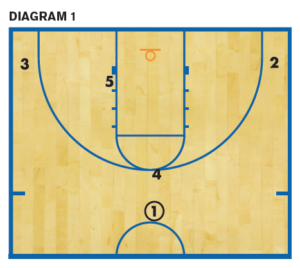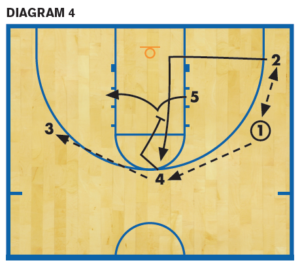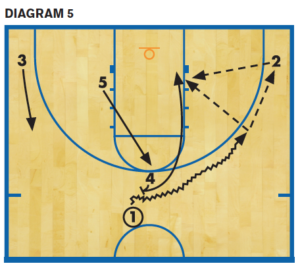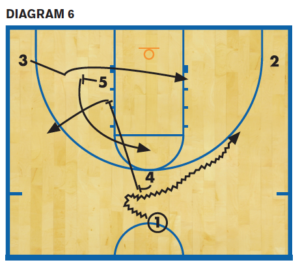Learning the three-down man offense
 The three-down man offense is a man package of plays that are designed to be quick-hitters. If shots are not manufactured, all players end up in the same group of spot-ups after each entry.
The three-down man offense is a man package of plays that are designed to be quick-hitters. If shots are not manufactured, all players end up in the same group of spot-ups after each entry.
The primary fast break that should be used in conjunction with this offense has all five players ending up in the same spot-ups. After the conclusion of the designated secondary fast break, the offense smoothly transitions into the desired continuity offense that can run indefinitely, while constantly maintaining offensive scoring pressure on the defense.
Maintaining possession of the ball prevents the opposition from scoring. Therefore, the best defense a team can have is the continuity offense it runs. This scheme is simply a three-phase process of offensive movement that eventually transcends into a half-court, man-to-man continuity.
This scheme is simply a three-phase process of offensive movement that eventually transcends into a half-court, man-to-man continuity.
DIAGRAM 1: Initial set. The three-down man offense aligns 1 at the top of the key with 2 and 3 in their respective deep corners. 4 is straddling the 3-point line at the top of the key facing either sideline, while 5 lines up on the first notch above the strong-side block.
After all entries are executed, 1 ends up on the ball-side block, 2 in the ball-side deep corner, 3 on the ball-side wing, 4 on the weak-side wing and 5 at the point (DIAGRAM 2).
At the conclusion of the primary fast break, either of the two options in the  North Carolina secondary break can be executed (DIAGRAMS 3-4). Using either variation will always put the five players in the same spot-up positions. From there, the secondary break can flow into the desired half court continuity offense that the coaching staff wants to utilize.
North Carolina secondary break can be executed (DIAGRAMS 3-4). Using either variation will always put the five players in the same spot-up positions. From there, the secondary break can flow into the desired half court continuity offense that the coaching staff wants to utilize.
Player skills
In this offense, 1 must be able to use both hands and adept at penetrating and pitching to 2 or 3. They also should be able to drive and dump to 5 or 4 in the low post, pull up for a medium range jumper, or drive and finish with a score.
The deep corner perimeter players (2 and 3) should be strong catch-and-shoot 3-point threats. The better the shooters, the more they can stretch the opposition’s defense. The more the opposition’s defense is stretched, the weaker it becomes, making the offense more productive.
 The low-post player (5) should be an aggressive 1-on-1 player who can receive the ball from the various passing angles with a high scoring efficiency from the field and free-throw line.
The low-post player (5) should be an aggressive 1-on-1 player who can receive the ball from the various passing angles with a high scoring efficiency from the field and free-throw line.
The second post player (4) must be unselfish, capable of setting ball screens and off-the-ball screens. If 4 can be a scoring threat, this offense is much more explosive.
Quick hitters
DIAGRAM 5: Entry one. This entry starts toward the weak side and is simply a two-man pick-and-roll for 1 and 4. As 1 dribble-scrapes off of 4’s top shoulder, 4 rolls to the basket and 2 remains in the deep corner. 3 lifts up to the weak side free-throw-line extended, while 5 breaks to the top of the key,  helping to isolate 4. If that doesn’t work, 1 looks to drive for a score or kick out to 2, 5 or 3.
helping to isolate 4. If that doesn’t work, 1 looks to drive for a score or kick out to 2, 5 or 3.
If no shots are taken, the offense has everyone in the proper spot-up positions to flow into the secondary break.
DIAGRAM 6: Entry two. 1 again receives the ball screen from 4 at the top of the key, with 3 running a flex cut to the new ball-side block position. After 4 ball screens for 1, 4 diagonally downscreen 5’s defender before stepping out to the weak side free-throw-line extended. 5 sets a flex backscreen and then rubs his defender off of 4’s downscreen. 2 remains spotted up in the deep corner.
 1 looks for a pull-up jumper, an interior pass to 3, a pitchout pass to 2, a reverse pass to 5, or a skip pass to 4 at the weak-side wing. If no shots are created, either secondary fast break can be used to continue the attack.
1 looks for a pull-up jumper, an interior pass to 3, a pitchout pass to 2, a reverse pass to 5, or a skip pass to 4 at the weak-side wing. If no shots are created, either secondary fast break can be used to continue the attack.
DIAGRAM 7: Entry three. This is basically a play designed to isolate 5’s defender, and it can be run toward the strong side of the offensive set.
1 sets up his man before dribble-scraping off of 4’s ball screen toward the free-throw-line extended on the left side of the court. As 1 turns the corner, 5 aggressively ducks in to the dotted circle in the center of the lane. If 5’s defender fronts, 1 should lob to 5; if they play behind, 1 should be able to make the inside pass to 5. However, if 5’s defender plays 5 on the high side, and 1 cannot make the pass, 1 should look to hit 3 in the deep corner for a jumper or for a  better inside passing angle to get the ball to 5.
better inside passing angle to get the ball to 5.
4, after ball-screening for 1, screens away from the ball for 2, who breaks to the top of the key to be a 3-point scoring threat. If no shot develops from this entry, the attack can flow into the secondary fast break and just as easily into the coach’s continuity offense.
John Kimble coached basketball for 23 years in Illinois and Florida at the college and high school levels, accumulating more than 340 victories. He has authored five coaching books.









